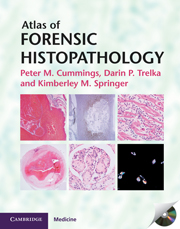3 - Thrombotic and embolic lesions
Published online by Cambridge University Press: 05 August 2013
Summary
INTRODUCTION
A frequent problem in forensic histopathology is evaluating the lumina of blood vessels for thrombi or emboli. In this chapter, the histological differences between antemortem and postmortem clots are described and non-thrombotic sources of emboli are reviewed. The most common type of embolus is a thrombus. Risk factors for formation of a thrombus fall under one or more of the following categories: hemostasis, hypercoagulability, and endothelial dysfunction (the Virchow triad). Deep leg veins are the most common source for pulmonary thromboemboli, but thrombi may originate anywhere. Grossly, antemortem clots appear homogeneous, dull, and cylindrical. In situ, the thrombus is usually adherent to the vascular intima. A thromboembolus retains the shape of the in situ thrombus and often protrudes from the incised surface of the embolized blood vessel. Postmortem clots tend to have a layered, shiny appearance, and are flatter, assuming the shape of the collapsed vessels. In practice, the differences between the gross appearance of antemortem vs. postmortem clots, particularly with the use of anticoagulants and thrombolytics, can be subtle. In these cases, histology is very helpful in making the call. Another use for histology is in cases of clinical disseminated intravascular coagulopathy, where microscopic fibrin thrombi may be seen.
- Type
- Chapter
- Information
- Atlas of Forensic Histopathology , pp. 36 - 47Publisher: Cambridge University PressPrint publication year: 2000



